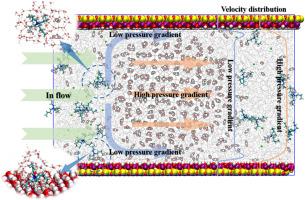Stabilizing effect of tetrabutylammonium bromide on CO2 hydrate in kaolinite nanopores: A molecular dynamics study under static and flow conditions
IF 4.6
0 ENERGY & FUELS
引用次数: 0
Abstract
The stability of CO2 hydrate in clay-rich porous media is fundamental to the safety of geological CO2 storage. While the TBAB is known as hydrate promoter, its stabilizing effect under the combined influence of thermodynamic condition and dynamic flow remains poorly understood. This study systematically investigates the stabilizing effect of TBAB on CO2 hydrate stability in the kaolinite pores by molecular dynamics simulation across a range of temperature (255–295 K) and pressure gradients (0–50 MPa/nm). It is found that TBAB mitigates hydrate decomposition by forming a continuous, protective TBA+-CO2-H2O ternary composite structure near the hydrate. Innovatively, it is found that the stabilizing mechanism is non-monotonic with respect to flow. The moderate shear flow could enhance stability by organizing TBA+ ions into a more effective barrier, whereas high flow rates disrupt this layer. Similarly, high temperature facilitates the escapement of CO2 from the ternary composite structure accelerating hydrate decomposition. These molecular-level insights offer crucial guidance for practical applications, informing the selection of favorable temperature conditions and suggesting that moderate injection flow rates may contribute to enhanced storage security. Ultimately, this work provides crucial insights for developing additives to ensure the long-term safety and efficiency of hydrate-based CO2 storage.

四丁基溴化铵对高岭石纳米孔中CO2水合物的稳定作用:静态和流动条件下的分子动力学研究
富粘土多孔介质中CO2水合物的稳定性是地质CO2储存安全的基础。虽然TBAB被称为水合物促进剂,但其在热力学条件和动态流动共同作用下的稳定作用尚不清楚。在温度(255 ~ 295 K)和压力梯度(0 ~ 50 MPa/nm)范围内,通过分子动力学模拟研究了TBAB对高岭石孔隙中CO2水合物稳定性的稳定作用。发现TBAB通过在水合物附近形成连续的、保护性的TBA+-CO2-H2O三元复合结构来减缓水合物的分解。创新地发现了稳定机制在流量方面是非单调的。适度的剪切流可以通过组织TBA+离子形成更有效的屏障来增强稳定性,而高流速则会破坏这一层。同样,高温有利于CO2从三元复合结构中逃逸,加速水合物分解。这些分子水平的见解为实际应用提供了重要的指导,为选择合适的温度条件提供了信息,并表明适度的注射流速可能有助于提高储存安全性。最终,这项工作为开发添加剂提供了重要的见解,以确保水合物基二氧化碳储存的长期安全性和效率。
本文章由计算机程序翻译,如有差异,请以英文原文为准。
求助全文
约1分钟内获得全文
求助全文

 求助内容:
求助内容: 应助结果提醒方式:
应助结果提醒方式:


